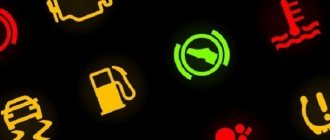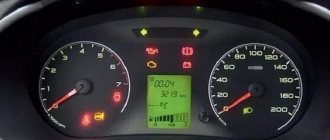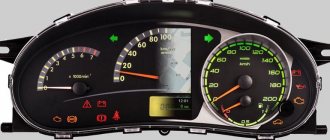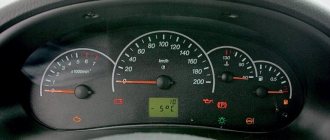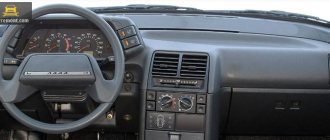Useful tips
On the dashboard of any car there are signal icons that inform the driver about the operation of certain mechanisms, as well as about malfunctions.
These icons help you always know what's going on with your vehicle.
Over the past few years, indicators have evolved from ordinary light bulbs to various glowing icons that are simple to understand, easy to see, and generally these indicators have become much more informative.
Different indicators have different colors.
What do the colors of the icons on the dashboard mean?
Red
Typically, red indicates a serious problem or some unresolved security issue. The color red is also used to indicate important reminders.
Yellow orange)
Typically, icons are colored yellow or orange to indicate that a particular part of the car requires repair or needs servicing. However, if the icon of this color begins to blink, then you should contact the workshop as soon as possible.
Green or blue
Icons of this color are used exclusively to provide the driver with additional information about the stable operation of the system.
Useful tips
* After one red or yellow indicator lights up, you should not wait for others to light up, since the longer you delay visiting the workshop, the greater the risk of an even more serious breakdown of the car increases, which can, in turn, lead to very unpleasant consequences.
* Try to carry out regular technical inspections, which will help avoid unexpected malfunctions. Always pay attention to the dashboard icons and you will be aware of the operation of all vehicle systems.
Don't forget about the information on the scoreboard!
By the way, in any case, the signs appearing on the panel are also a reason to find out the reason for the warning on the information board itself. To better understand the problem, you should open the “Machine Information” section there. To do this, you need to enter the menu and, by switching up or down, confirm your choice. This way you can find out what exactly the illuminated danger sign is telling you. As already mentioned, in some cars the exclamation mark can indicate not only defects in the brake system; in such cases, a description of the malfunction is displayed on the message display in the center of the dashboard.
Dashboard icons
Warning symbols
1. Front fog lights are on.
2. Such an indicator may mean: a malfunction in the electric power steering or power steering.
3. Rear fog lights are on.
4. Low level indicator for windshield washer fluid.
5. The brake pads are worn out and need to be replaced.
6. An indicator indicating that the constant speed control system is turned on (cruise control).
7. Indicators of working turn signals.
8. Indicator of active rain and light sensor.
9. An indicator indicating that the outside temperature is below zero.
10. Information message.
11. Glow plug indicator.
What do the icons on the dashboard mean?
26. Towbar warning indicator.
27. Air suspension warning indicator.
28. Lane change indicator.
29. Indicator indicating catalyst overheating.
30. Indicator indicating that the seat belt has not been fastened.
And such an indicator warns that the seat belts of the rear passengers are not fastened.
31. If the handbrake icon turns on, it can mean one of three things:
* The handbrake lever is raised.
* Brake pads are worn out.
* Low brake fluid level - it needs to be topped up or replaced.
If the car is equipped with an electronic handbrake, then this indicator informs about a problem with the limit switch or sensor.
You can also find an indicator that informs you that the brake fluid level is below normal.
32. Battery charge indicator.
33. Parking assistance system indicator.
34. Indicator indicating the need for maintenance.
35. Adaptive headlights are on.
36. Problems with the automatic headlight leveling system.
37. Problems associated with the rear spoiler.
38. This indicator can be found in convertibles and signals a problem with the car's roof.
39. There is a problem with the airbag.
Dashboard indicators
40. The red exclamation point can have several explanations, and it looks different:
* If the sign is in a circle, there is a problem with the brake system. It is better to stop and not continue driving.
*Handbrake activated.
* Brake pads are worn out.
* Low brake fluid level. This is the most annoying problem as the brake hose may have been damaged.
Quite often this indicator lights up if the float (level sensor) is faulty.
In some cars, this indicator is accompanied by the word “BRAKE”, but its essence remains the same.
41. Water was detected in the fuel filter.
42. Side Airbag Off - translated as “the side airbag is turned off.” The same icons may indicate that the front airbag is disabled.
43. Fault detected.
44. Low beam headlights are on.
45. The indicator indicates that the air filter is dirty.
46. Fuel saving mode activated. This indicator looks different on different cars.
What you can do yourself
Try removing the connector from the cap of the reservoir where the brake fluid is located, pull off the rubber boot from it and, if it appears wet from the fluid, blow it out and wipe it clean. Check to see if the exclamation mark has gone out. Put the connector on. If the indicator lights up again, then the level sensor is most likely faulty. It happens that brake fluid gets into the middle part of the cover and closes the contacts. To do this, you need to disassemble the lid, clean and dry it. A similar operation can be done at home.
Symbols on the dashboard
47. Assistance and safety system indicators
These indicators show the activity of the hill descent assist system or the safety system while driving uphill.
48. Red - the temperature of the cooling system is higher than normal.
The same blue indicator indicates that the cooling system temperature is below normal.
49. ABS - Antilock Braking System.
This indicator lights up when:
* Malfunctions in the ABS system
*ABS has been intentionally disabled.
50. An indicator indicating water in the fuel system or other problems associated with this system.
51. The indicator lights up when the door is open.
52. The indicator lights up when the hood is open.
53. Low fuel level indicator.
54. Indicator indicating a problem with the automatic transmission. The automatic transmission or other parts of the transmission may overheat.
55. Automatic Speed Limiter (ASL) is turned on.
56. Suspension shock absorber indicator.
57. This icon can mean:
* The pressure level in the engine lubrication system (Oil Pressure) has dropped.
* Oil level is below the permissible value.
58. Indicator that the windshield heating is on.
59. Indicator informing about an open trunk.
What do the different signs on the dashboard mean?
60. Stability Control is disabled.
*If the Check Engine light is on, this system will automatically turn off.
Different manufacturers have their own names for this system: Automatic Stability Control (ASC), Dynamic Stability Control (DSC), Vehicle Dynamic Control (VDC), Vehicle Stability Control (VSC) and others.
If the knees begin to slip, the system will begin to level the vehicle using the brake systems, suspension control system, and fuel delivery system.
If the icon blinks, there is an electrical problem with the cooling system.
61. The rain sensor is turned on.
62. When the engine is running, this indicator warns that the engine and its system require diagnostics. This may cause some vehicle systems to shut down and stop working until all problems have been properly corrected.
63. The indicator informs you that the rear window heating is on.
64. Automatic windshield cleaning is activated.
How do indicators work differently in cars with and without ABS?
If the car has the named system, then the warning lamp (also called the indicator icon) should normally light up when the ignition is turned on and the parking brake is applied, and go out after starting the engine and when the parking brake is released. This is how the system is tested. And if the light goes out, it means the system is working properly. An indicator signal that glows longer than expected indicates a malfunction in the vehicle's systems. If ABS is not installed, then when the ignition is turned on, the icon appears only if problems arise, which we will discuss in more detail below.
Description of other important dashboard indicators
Engine Oil Sensor - engine oil level indicator.
An icon with the inscription MAIN usually appears in hybrid models, and it informs about a problem in the power supply system.
The following indicators indicate malfunctions. They are part of the car's security systems.
This indicator lights up along with a warning message on the instrument panel screen.
In European cars, a similar yellow indicator indicates a malfunction of the stability control system.
SRS - Supplemental Restraint System. If this icon lights up, the passive safety system informs you that the airbag is faulty.
Vehicle system malfunction sensors and safety warnings
RSCA - Roll Sensing Curtain Airbags. This indicator turns off automatically when an adult gets into the car. If the message AIRBAG OFF is on, then a malfunction has been found in the system.
The indicator, which is responsible for the passenger airbag, informs about the status of the passenger airbag.
If this icon lights up, it means that the side airbag system, which should be activated when the car overturns, is not functioning. The system can be turned off when the driver is about to drive off-road, as due to large body rolls, the system sensors can be activated.
PCS - Pre Collision (Crash) System. This indicator informs you that the pre-collision safety system is not working.
Anti-theft immobilizer icon. This indicator informs about the activation of the immobilizer (anti-theft system). When this indicator lights up, there may be problems with the anti-theft system.
This type of indicator is typically found on sports cars. It can warn about:
* Transmission overheating. There is a danger that the vehicle will become uncontrollable.
* Clutch problem.
* Faults in one of the transmission units.
Transmission oil temperature is too high.
(A/T - Automatic Transmission)
This icon indicates that the temperature in the automatic transmission is above the permissible level. In this case, it is not recommended to continue driving. You should wait until the automatic transmission cools down.
Electrical fault in the automatic transmission. Also, don't keep moving.
Automatic transmission lock mode indicator in the “parking” position.
P - parking
A/TP - Automatic Transmission Park
As a rule, such an indicator can be found in cars that are equipped with all-wheel drive, and also contain a reduction range in the transfer case.
The transmission locks when the all-wheel drive mode switch is in position (N).
If your indicator is on, which shows an automatic transmission, and under the picture there is the inscription “auto”, then this may mean:
* The oil level in the box is too low.
* Low oil pressure.
* Fever.
* Sensor malfunction.
* Electrical wiring fault.
It is worth noting that in such cases the box goes into emergency mode (i.e. 3rd gear is activated).
This indicator is called "shift up". It informs you that for the greatest fuel economy you should switch to a higher gear.
Malfunction in the brake force distribution system.
Problems with the electric parking brake system.
Start-Stop system indicator.
The green indicator indicates that the car's engine is turned off.
The yellow indicator informs about a malfunction in the system.
This indicator indicates a decrease in engine power. This problem can sometimes be solved by turning off the engine and restarting it after 10 seconds.
This indicator lights up in 4 cases:
* Problems in the transmission electronics.
* Problems with engine operation.
* Malfunction of the injection system.
* Malfunction of the immobilizer (electronic anti-theft device).
Lambda probe icon.
This indicator lights up if the oxygen sensor is dirty or faulty.
Further movement is not recommended, as this sensor has a direct impact on the operation of the injection system.
When this indicator comes on, it means the catalytic converter is overheating or malfunctioning. In addition to the activation of this icon, engine power usually drops.
This light tells you to check your fuel cap.
If this indicator is on, it may mean the following:
* Another indicator turned on.
* A new message has appeared on the instrument panel.
* Certain service functions must be performed.
Please refer to your vehicle's owner's manual.
Low coolant level in the engine cooling system.
Problems with the Electronic Throttle Control (ETC) system.
BSM - Blind Spot - this is the designation for the blind spot monitoring system.
1. The system is disabled.
2. The system is faulty.
Icon meaning:
1. It's time to do scheduled maintenance, change the oil, etc.
2. Serious problems that need to be fixed.
The intake system air filter needs to be replaced as it is dirty.
Night View - this is the designation for the night vision system. This icon means that:
1. An error has occurred in the system.
2. Infrared sensors have burned out.
Overdrive - O/D (“overdrive”) - overdrive gear. This indicator indicates that the overdrive gear in the automatic transmission is turned off.
Warning icons
Such messages are displayed on the dashboard in yellow or red. Let's list the most popular options.
The icons warn that the temperature in the cooling system is not all right. The red icon indicates its overheating, the blue icon indicates low temperature. A flashing picture indicates a defect in the electrical circuit of the system.
Problems with oil pressure in the system, which ensures the normal functioning of the power plant, or its low level. The icon appears when the engine is turned on, and may appear while driving.
This icon indicates unstable operation of the engine, errors in the operation of the electronics of the motor unit. To fix the problem, diagnostics are required.
The icon appears when the key is turned in the ignition, then it disappears. A constant glow indicates problems with the battery charge, a defect in the generator or its drive, and also indicates insufficient voltage in the vehicle’s on-board network.
The yellow steering wheel on the instrument panel indicates that the unit needs to be adapted. The fuel supply is running low and requires refueling.
A low level or lack of fluid in the windshield wiper expansion tank is the reason for the appearance of this icon. This icon warns of a catalyst malfunction or overheating of the catalytic element. It also indicates that there are problems with the vehicle's ignition system.
This icon warns of low-quality fuel poured into the tank and problems with the exhaust gas purification system. The handbrake is activated, this icon warns. In a car with an electric handbrake, this icon appears when parts of the device are defective. This icon indicates that the immobilizer system is operational. The red icon warns the machine owner that this protective device is faulty.
The icon indicates that the immobilizer system is activated and the vehicle’s power plant is blocked. A similar icon is usually present on cars of Japanese manufacturers, in particular Toyota. The indicator starts flashing when the key is removed from the ignition switch. When a key is inserted, the light comes on and goes out after three seconds if the device considers this key to be the “correct” one. Otherwise it continues to blink. A constant light indicates a defect in the device.
Such icons can be displayed on the instrument panel of cars of different brands. However, they have one meaning: the level of the power unit’s cooling liquid has approached a critical value. This icon indicates that the air filter has expired and requires replacement. Malfunction of ETC - electronic throttle valve.
The appearance of such icons indicates a failure in the stabilization system. However, the car does not lose control. The presence of such icons on the panel will remind the driver to carry out scheduled maintenance, change the oil in the engine compartment, and also require service to solve current problems. Activation of Snow Mode, which allows you to use increased speeds at the start and while driving. The driver monitoring system believes that he needs a rest.
These icons indicate that the adaptive cruise control function is activated. This device helps maintain the desired speed to avoid a collision with the car in front. Activating the travel mode with a tow hitch.
Meanings of the assistance and stabilization system icons on the dashboard
The traction control indicator may be indicated differently:
TRAC - Traction and Active Traction Control
DTC - Dynamic Traction Control
TCS - Traction Control System
Green indicator - informs about the operation of the system.
Yellow indicator - the system is turned off or an error has occurred in its operation.
* It is worth noting that this system is connected to the braking system as well as the fuel supply system, and therefore faults in one (or both) of these two systems may cause the traction control system to disable.
ESP - Electronic Stability Program - this is the designation for the emergency braking assistance system
BAS - Brake Assist System - this is the designation for the stabilization assistance system. Both of these systems are interconnected, and this indicator indicates problems in one of these systems.
KDSS - Kinetic Dynamic Suspension System - this is the designation for the kinetic suspension stabilization system. This indicator indicates a malfunction in this system.
Vehicle Stability Control (VSC), Dynamic Stability Control (DSC) stabilization system indicator icon.
For some car manufacturers, this icon denotes an electronic locking differential, in short EDL (Electronic Differential Lock), as well as an anti-traction system, briefly designated ASR (Anti-Slip Regulation).
This indicator can indicate that:
1. The system needs diagnostics.
2. All-wheel drive is engaged.
BAS - Brake Assist System - assistance system in case of emergency braking.
ASR - Electronic Anti-Slip Regulation - electronic traction control system.
If this indicator lights up, it means that there has been a failure in the BAS system, which in turn leads to the deactivation of the ASR system.
IBA - Intelligent Brake Assist - intelligent assistance system in case of emergency braking. This system automatically activates the braking system if an obstacle appears dangerously close to the vehicle.
This indicator indicates that the IBA system is deactivated. But if the system works and the indicator is on, then there is a problem with the system's laser sensors.
This indicator indicates that the car is slipping, which means that the stabilization system has turned on.
This indicator informs you that the stabilization system is malfunctioning or that it is not functioning.
In this case, you can continue to drive the car, but the electronics will not help you stay on a slippery road.
Information icons
Let's look at the purpose of the main icons that appear on the instrument panel. On different cars from different manufacturers, they may differ in size and shape, but their essence remains unchanged.
In this review, we will talk about the main icons that most cars have.
A group of information icons shows the status of the machine systems. Depending on this factor, they may have a green or yellow, in some cases, backlight.
This icon indicates that the car doors are not closed. The red color informs that in this case the movement should be stopped in order to ensure the safety of the driver or passengers of the car during the trip, and the safety of other road users. The reason for this factor may be simple inattention of the driver or passenger or a malfunction of the limit sensor or poor contact.
The icon informs that the car is not protected by a security system (immobilizer, central locking, alarm). If the icon flashes, the security system is working.
This image shows: there are problems with the operation of the power unit or gearbox. The car owner should diagnose these components.
A similar picture lights up on the instrument panel of hybrid car modifications. A constant or flashing indication informs about a malfunction of the electric drive.
This icon reminds you that the maintenance deadline has come. After it has been carried out, the car service technicians reset the image.
The Stabilization Program (ESP) sensor informs the driver when passing a section of the road with a slippery surface. The icon calls for careful driving in this place to avoid slipping, and also shows the start of ESP operation. The appearance of a wrench symbol or a triangle next to this icon indicates a malfunction of this system.
The icon indicates that the passenger or driver is not wearing a seat belt. When you start moving, this image is duplicated with a sound alert, the picture begins to blink.
The hood of the car is not secured.
Special and additional indicators on the car dashboard
The following indicators can be found in modern vehicles equipped with new technological features.
The green indicator indicates that the function is active.
There are symbols that indicate a problem with a specific function. Typically, such indicators are yellow or red.
The indicator tells the driver that it is time to rest.
Easy access to the car.
Adaptive cruise control activated
Problems with cruise control.
Lane Keeping Assist Indicator.
Such icons may mean:
1. Collision safety system disabled
2. Malfunction in the collision safety system.
The indicator informs you about the risk of a collision at the rear of the vehicle.
The indicator indicates a risk of collision at the front of the vehicle.
Be careful, there is a pedestrian on the road.
The indicator informs you that there is a vehicle in the blind spot.
The indicator informs you that the brake pedal is pressed.
The indicator informs you that the SPORT suspension mode is on.
Towing mode / Indicator indicating the presence of a trailer.
What to do if two icons are on - “exclamation mark” and “ABS”
This is a fairly typical situation, which only means that the malfunction was noticed by two control algorithms at once. It is unlikely that a failure in the brake system will not be noticed by the ABS unit and then go into emergency mode and illuminate the malfunction indicator.
As well as the opposite situation, when the car will be allowed to move further in case of critical problems with the anti-lock braking system and will not give a signal in the form of a red exclamation mark.
You need to immediately start troubleshooting and not risk driving with problem brakes, although there are also quite prosaic reasons - when driving on a half-flat tire, the system will notice that one is spinning faster than the others and will mistake it for a problem with ABS.
Explanation of icons on the dashboard of all-wheel drive vehicles
All-wheel drive mode activated (AWD - All-wheel Drive)
The indicator indicates that the all-wheel drive mode with a low range in the transfer case has been engaged.
Central differential lock indicator. The car operates in “hard” all-wheel drive mode.
Rear differential lock indicator
The indicator indicates that all-wheel drive is deactivated.
The indicator informs about a four-wheel drive malfunction.
Warning
Of course, in this case, it is best to find the nearest service center to check the car's braking system. By the way, on the way to an unscheduled inspection, you need to be prepared for the fact that you will have to press the pedal harder if you need to brake. And also to the fact that the free play of the said pedal will increase, as will the braking distance of your car. By the way, if the icon lights up along with the ABS indicator, then when braking, premature locking of the rear wheels is possible.
